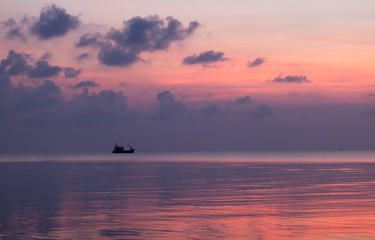Five countries account for 90 percent of distant-water fleet effort

The global distant-water fishing industry benefits just a handful of fishing countries, while capturing the bounty of coastal nations that often have poor governance and limited resources.
A new report published by the Stimson Center identifies the top distant-water fishing fleets in the world, where they operate, and their connection to illegal, unreported, and unregulated (IUU) fishing. The report argues that the current distant-water fishing industry is unsustainable, and makes concrete recommendations for how to increase transparency and accountability.
Just five countries are responsible for 90 percent of distant-water fishing effort. China and Taiwan alone account for 60 percent of distant-water fishing activity, while Japan, South Korea, and Spain account for about 10 percent each. Today’s major distant-water fishing nations are different than decades past: Up to the mid-1990s, the distant-water fleet was dominated by the Soviet Union, Japan, and Spain. Since then, as Russia and European countries slowed their operations, Chinese and Taiwanese fleets grew to become the leading fleets globally.
The distant-water fleets target high value fish in locations where governance and enforcement are limited, primarily in the Pacific, East Africa, and West Africa. Specifically, Kiribati, Seychelles, and Guinea-Bissau received the highest number of distant-water vessels in their exclusive economic zones (EEZs) in each of those three regions.
Distant-water fleets often target fish-rich areas with easy access to markets and low governance capabilities. High value species such as tuna are popular, with more than two-thirds of the top five fleets targeting tuna. In many cases, the fleets’ domestic fisheries are in poor shape. China, for example, has expanded its operations from Pacific to East and West Africa and even South America as its domestic fisheries have declined.
The majority of distant-water vessels are authorized, flagged vessels, but many underreport their catch, according to Sally Yozell, author of the report and director of the Environmental Security Program at the Stimson Center. These vessels fish in other countries’ coastal waters, but don’t land fish there or invest in the local economy, depriving communities of jobs in industries such as fish processing and vessel servicing.
“Overall, the secrecy around distant-water fishing and its incentive structure paint a picture of exploitation of coastal nations’ resources,” Yozell told SeafoodSource. “These countries experience negligible short-term gains at the cost of long-term fisheries loss.”
The report was based on AIS location data and more than 50 interviews with government officials, nongovernmental organizations, and private sector representatives around the world. The researchers also conducted in-field assessments in Mozambique and Seychelles.
The activities of the Chinese fleet dwarf the others, representing almost 40 percent of all the top 10 distant-water fleets’ activities in other countries’ EEZs. China’s distant-water efforts grew after its 1986 National Fisheries Law that spurred the development of fishing capacity domestically and internationally ended up leading to overfishing and the collapse of domestic fisheries. Today, Beijing requires the distant-water fleet to send 60 to 65 percent of the catch back to Chinese markets. There are plans to cap the number of vessels at 3,000 by 2020, even as the government continues to subsidize vessels, the report notes.
The report recommends building coastal nations’ local capacity and transparency to prevent exploitation and corruption, warning that fisheries will collapse without significant improvements in fisheries management.
Mandating that vessels have and use automated information systems (AIS) and vessel monitoring systems (VMS) would ensure they can be tracked and their fish traced from catch to market, the report argues. Distant-water fishing access agreements should be public so government officials and businesses can be held accountable. The revenues from those access agreements should also be reinvested in improving capacity to combat IUU fishing.
International organizations and coastal nations could create a legal framework that mandates location data be collected and shared, while the maritime insurance industry could stipulate that vessels must have AIS and VMS transponders always on to acquire insurance.
“Transparency across the seafood supply chain should be the social license for the fishing industry in the 21st century,” Yozell said. “By ensuring transparency as a precondition for catch entering the global marketplace, the seafood industry can level the playing field for honest fishers, reduce incidences of IUU fishing, and ensure that their catch is not being laundered with illegally caught fish.”
Additionally, nations should eliminate subsidies that raise the fishing capacity of distant-water vessels; including those for vessel modernization, tax incentives and rebates, and fuel subsidies, the report suggests. And the authority of regional fishery management organizations should be expanded.
"Governments must collaborate internally across agencies and externally with other nations to regulate their seas," retired U.S. Navy Admiral Michelle Howard, who spoke at the event launching the report, said in a statement.
Photo courtesy of Colleen Slater/Shutterstock






Share